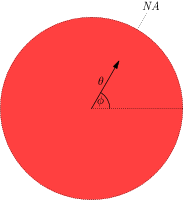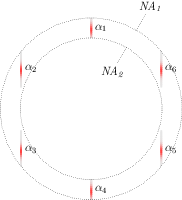5. Input Beam patterns¶
To simulate the light field of an incident beam of given type through a given optical medium, the following functions provide the initial conditions of the complex field, which then are propagated through the medium:
5.1. Gaussian/Bessel beams¶
Gaussian/Bessel beams


-
biobeam.focus_field_beam_plane(shape=(128, 128), units=(0.1, 0.1), z=0.0, lam=0.5, NA=0.6, n0=1.0, ex_g=None, n_integration_steps=200)¶ calculates the complex 2d input field at position -z of a perfect, aberration free optical system
Parameters: - shape (Nx,Ny) – the 2d shape of the geometry
- units (dx,dy) – the pixel sizes in microns
- z (float) – defocus position in microns, such that the beam would focus at z e.g. an input field with z = 10. would hav its focus spot after 10 microns
- lam (float) – the wavelength of light used in microns
- NA (float/list) – the numerical aperture(s) of the illumination objective that is either a single number (for gaussian beams) or an even length list of NAs (for bessel beams), e.g. NA = [0.5,0.55] lets light through the annulus 0.5<0.55 (making a bessel beam ) or NA = [0.1,0.2,0.5,0.6] lets light through the annulus 0.1<0.2 and 0.5<0.6 making a beating double bessel beam…
- n0 (float) – the refractive index of the medium
- n_integration_steps (int) – number of integration steps to perform
Returns: ex – the complex field
Return type: ndarray
Example
>>> # the input pattern of a bessel beam that will focus after 4 microns >>> ex = focus_field_beam_plane((256,256), (0.1,0.1), z = 4, lam=.5, NA = (.4,.5))
See also
biobeam.focus_field_beam()- the 3d function
5.2. Cylindrical light sheet¶

-
biobeam.focus_field_cylindrical_plane(shape=(128, 128), units=(0.1, 0.1), z=0.0, lam=0.5, NA=0.3, n0=1.0, ex_g=None, n_integration_steps=200)¶ calculates the complex 2d input field at position -z of a for a perfect, aberration free cylindrical lens after x polarized illumination via the vectorial debye diffraction integral.
Parameters: - shape (Nx,Ny) – the 2d shape of the geometry
- units (dx,dy) – the pixel sizes in microns
- z (float) – defocus position in microns, such that the beam would focus at z e.g. an input field with z = 10. would hav its focus spot after 10 microns
- lam (float) – the wavelength of light used in microns
- NA (float) – the numerical aperture of the lens
- n0 (float) – the refractive index of the medium
- n_integration_steps (int) – number of integration steps to perform
Returns: ex – the complex field
Return type: ndarray
Example
>>> # the input pattern of a bessel beam that will focus after 4 microns >>> ex = focus_field_cylindrical_plane((256,256), (0.1,0.1), z = 4., lam=.5, NA = .4)
See also
biobeam.focus_field_cylindrical()- the 3d function
5.3. Bessel Lattices¶

-
biobeam.focus_field_lattice_plane(shape=(256, 256), units=(0.1, 0.1), z=0.0, lam=0.5, NA1=0.4, NA2=0.5, sigma=0.1, kpoints=6, n0=1.0, apodization_bound=10, ex_g=None, n_integration_steps=100)¶ calculates the complex 2d input field at position -z of a for a bessel lattice beam.
Parameters: - shape (Nx,Ny) – the shape of the geometry
- units (dx,dy) – the pixel sizes in microns
- z (float) – defocus position in microns, such that the beam would focus at z e.g. an input field with z = 10. would have its focal spot after 10 microns
- lam (float) – the wavelength of light used in microns
- NA1 (float/list) – the numerical aperture of the inner ring
- NA2 (float/list) – the numerical aperture of the outer ring
- sigma (float) – the standard deviation of the gaussian smear function applied to each point on the aperture (the bigger sigma, the tighter the sheet in y)
- kpoints (int/ (2,N) array) – defines the set of points on the aperture that create the lattice, can be
- a (2,N) ndarray, such that kpoints[:,i] are the coordinates of the ith point
- a single int, defining points on a regular polygon (e.g. 4 for a square lattice, 6 for a hex lattice)

- n0 (float) – the refractive index of the medium
- apodization_bound (int) – width of the region where the input field is tapered to zero (with a hamming window) on the +/- x borders
- n_integration_steps (int) – number of integration steps to perform
- return_all_fields (boolean) – if True, returns u,ex,ey,ez where ex/ey/ez are the complex vector field components
Returns: u – the 2d complex field
Return type: ndarray
Example
>>> u = focus_field_lattice_plane((128,128), (0.1,0.1), z = 2., lam=.5, NA1 = .44, NA2 = .55, kpoints = 6)
See also
biobeam.focus_field_lattice()- the corresponding 3d function
